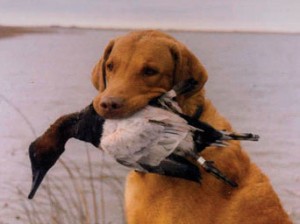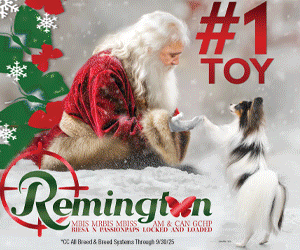Creative Genius
By Chris Robinson
 There has been a lot of publicity, in recent years, about the value of “independent thinkers” in any organization. The ability to be creative in thinking, to think “outside the box,” “around the box” and “through the box” is a greatly prized trait in most situations. That being the case, my dogs over the years should have been eligible to lead the canine equivalent of the most successful Fortune 500 companies. Because “groupthink,” a faulty decision-making process that leads to a low probability of success, has never been one of their faults. If anything, their various failures in the field, the obedience ring or the show ring have been the direct result of them being way too creative. In fact, there have been times when they were downright creative geniuses.
There has been a lot of publicity, in recent years, about the value of “independent thinkers” in any organization. The ability to be creative in thinking, to think “outside the box,” “around the box” and “through the box” is a greatly prized trait in most situations. That being the case, my dogs over the years should have been eligible to lead the canine equivalent of the most successful Fortune 500 companies. Because “groupthink,” a faulty decision-making process that leads to a low probability of success, has never been one of their faults. If anything, their various failures in the field, the obedience ring or the show ring have been the direct result of them being way too creative. In fact, there have been times when they were downright creative geniuses.
It all began with the foundation sire of my line of retrievers. He had definite ideas about what was proper work for the breed and what was not. Anything that had the potential to result in birds in his mouth was positive. Anything else, like obedience or the conformation ring, was not only boring but pointless. While he eventually achieved his utility degree in obedience and finished his conformation championship in both the U.S. and Canada in style with group wins, the road to both was strewn with potholes, some of which were big enough to conceal a full-sized pachyderm. He delighted in devising new and different ways to do obedience exercises. He was, in the terms that define creative genius, both flexible and a “possibility thinker.”
Creative geniuses persistently think about the possibilities that are available to them at any one moment in time and they understand that focusing on these possibilities will expand their opportunities. In obedience, there are usually two people, two possibilities, in the ring—the dog’s handler and the judge. So, what does it matter to which one you present the dumbbell after a retrieve? After all, it’s only a piece of wood, not something of great value like a duck, pheasant or goose, which the boss clearly wanted. As long as it gets to one or the other, the retrieve has successfully been made. Or at least that was apparently the dog’s thinking as there he sat, before the judge, in a perfectly straight “sit” patiently waiting for her to take the gift he was offering.
The same occurred in utility when he must have assumed that since the judge had been the one taking the leather dumbbell and putting it in the stack, it must be his. Therefore, it should be returned to its rightful owner. When the judge declined, the dog moved forward and nudged his hand. When he got no response, he moved a little closer and nudged the judge’s hand a bit harder. “Hey, here’s your dumbbell. Take it.” Again, no response. Frustrated by his inability to get the judge’s attention, the dog rose on his hind legs, put his paws on the judge’s chest so they were eyeball to eyeball and stuck the dumbbell in the judge’s face. Nearly collapsing with laughter, along with the gallery, the judge finally capitulated and accepted the dog’s offer to give him give back “his” property.
It was only slightly better in the show ring. The only aspect he liked about dog shows was the liver treats. They almost made a useless exercise worthwhile. Almost, but not quite. His antics in the show ring definitely livened up what to him was dull to the point of ennui. Trotting around a ring with no discernible objective? Ridiculous! Standing a certain way? Absurd! Enduring a cold-handed judge placing their hands everywhere on your body? Embarrassing and intolerable! But, a wiggle here, a change in foot placement there, a tail-in-the-face at every opportunity? Let the good times roll and give me a hunk of garlic-laced liver!
It wouldn’t have been so bad if his creativity had been confined to just him but apparently it was a dominant genetic trait because he passed it along to all of his descendants and, five generations later, I’m still dealing with this “creative genius.” However, there is some evidence it may not have been a genetic trait but rather a virus because it also infected the Brittanys who lived with him and his descendants.
The first Brit possessed the “imaginative” characteristic of creative genius as she utilized the full capacity of her resourcefulness to bend the laws of reality. She was convinced she had been “born to the purple” and should be treated as “her imperial highness.” I’ll concede that she did have a number of blue-blooded ancestors sporting the title of dual champion but she carried it to the extreme. She was an absolute bird finding machine in the field but so temperamental that she put the most tempestuous diva that ever trod the boards of the Metropolitan Opera to shame. Her human hunting partners frequently found themselves pussy-footing around her in order to keep her in good humor. On numerable occasions, something—we never quite knew what—that we did would insult or annoy her and she would stalk off in high dudgeon to hunt for herself but staying well within the hunters’ sight albeit completely out of shotgun range as she demonstrated on bird after bird just how really good she was in the field. Unfortunately, about the time you realized she was on point, she would carefully and deliberately crowd the bird just enough to cause it to break cover and fly well out of range of anything but the 16-inch guns of a battleship. She made sure you clearly understood that she was punishing you for your transgression.
It made the people hunting with her so edgy that they went to great lengths to avoid offending her. On one occasion, when we were hunting on a state wildlife management area, before I could get either a bell or her beeper on her, she jumped off the truck’s tailgate and was off to the races while I helplessly screamed, whistled and yelled at her to “Get in here.” Finally, when she had checked out every single objective on the entire management area, she returned to the truck, panting but quite pleased with herself. I rather roughly snatched her up and set her down quite firmly on the truck’s tailgate with the harsh order to “Now stay there!” Whereupon my hunting partner grabbed my hunting jacket, spun me around and cried, “Don’t make her mad!”
The retrievers’ creative genius did not stop at the ring gate. The second generation improved and enhanced that creativity in the field. This was a bonus when we were actually hunting because a dog that can think for himself and solve problems, a dog that is fully focused and mentally locked on the goals they seek, fully committed and dedicated to the outcomes and objectives they want, is a treasure beyond words. However, in the retriever field dog games, it’s a major liability. Which, come to think of it, says something about retriever hunt tests and more particularly about retriever field trials and what it says does not reflect well on either program.
Despite being just about the best kind of dog to accompany you on a hunt, Chief qualified as a creative genius in the dog field sports because he fully understood the principle that without risk there can be no worthwhile rewards. He was therefore willing to take risks by thinking differently, by taking chances and by utilizing creative techniques and strategies in a unique, untried and unorthodox manner. He quickly determined that if the shortest, quickest way back from picking up a bird meant he should get out of the water and run the shoreline, that’s what he would do. Like any creative genius, he would not allow distractions or circumstances to push him off this course of action which speedily resulted in him being ruled out as a field trial dog because anything that makes absolute sense to the dog, or any rational human being for that matter, is an anathema to retriever field trial folks. He also forcefully and frequently graphically declined to bring back birds that were clearly long past prime in the edibility department which did not endear him to many hunt test organizations both north and south of the Canadian border where old, many-times-used-birds were often de rigeur. Having established what he considered proper technique for playing retriever field games, he passed these attributes along to his son with some he inherited from his father but had not had much occasion to use since a puppyhood accident kept him out of the show ring.
The dog in the third generation was call-named “Duke” because he walked with the same sort of arrogant swagger as John Wayne and, like his human counterpart, projected an aura of authority, autonomy and slumbrous power. But, like his creative genius predecessors, he understood that lasting freedom from “herd mentality” took commitment along with being an independent thinker and doer. From his grandfather, he inherited contempt for unproductive (in his view) activities like obedience and dog shows although he earned both an American and Canadian championship and owned many group wins and placements in both countries as well as a companion dog title in each country. His success in the show ring came about chiefly because judges were attracted to his near-perfect conformation and his arrogance. He was handsome and he knew it. But, he would not perform in the show ring unless there was an incentive both before and after his ring appearance–the liver treats in the ring he viewed as merely his due. So, before each and every ring appearance, someone, usually me, had to throw several retrieving dummies for him to fetch and, if he won the breed, this had to be repeated after he left the breed ring and before he entered the group ring.
In the field, he had definite ideas about what he would and would not do. For example, he would not “do” boats having decided early in his life that they were untrustworthy things that would dump him in cold water without him having any say in the matter. Not that he opposed swimming in cold water because he did it willingly on numerous occasions on waterfowl hunts in Canada. It was just that he believed it should be his choice whether to enter cold water and not the whim of some inanimate object like a boat. He also didn’t have much time for the kind of steadiness required of dogs at the advanced levels in hunt tests although he did earn his senior hunter title. This lack of interest in being steady to wing and shot was the result of having failed on more than one occasion on a real hunt to bring back a pheasant that was hit but not killed and managed to escape. He had determined that if he was essentially under the bird when it is hit, the chances of the bird not being retrieved were considerably minimized which, although absolutely correct and desirable procedure when we were actually hunting, created a lot of conflict for his beleaguered owner in the hunt test game. I never knew if he was going to be steady, as he’d been trained to be, or creative as his instincts told him to be.
The “creativity virus” also infected the second Brittany, whose actual call name was “Belle” but who was known far and wide as “Abu, the tiny terrorist in a Brittany suit.” It should have been obvious that she was an independent thinker from the day she arrived. Carried into the house as an eight-week-old puppy, she immediately made two very high-speed circuits of the entire downstairs pulling every pillow off the couch and knocking over a plant in the corner just in passing.
Her personal bête noire was pheasant roosters that she perceived were taunting her. We both trained and hunted frequently on a game farm. One year, there was a particular rooster that truly annoyed her. She had pointed it several times during the hunting season without ever being able to successfully pin it with the result being that the bird managed to run away and then fly away just out of shotgun range cackling its derision toward all hunters, pointing or flushing dogs, and particularly irking a certain Brit. When the hunting season ended, the bird was a survivor with all the skills that entails. Several occasions during the time she was training for her senior hunter title, she found that same bird and, each time, he not only escaped but went out of his way to humiliate her in the process. To say she held a grudge against this particular bird would be an understatement. Unfortunately the match between the two finally came to a head when she was going for her final qualifying score in senior. As she hunted along the edge of a cornfield on the back course, she caught the scent of her enemy. This time, she was not about to cut him any slack by stopping and pointing.
She took off at speeds estimated as ranging between Mach 1 and 2 down the rows of standing corn in hot pursuit. Even the bird understood that this time she truly meant business and he also hit the afterburners secure in the knowledge that there wasn’t a dog alive that he couldn’t outrun. But, he failed to take into consideration the additional speed and determination generated by Abu’s sheer hatred of that particular bird. When she got close enough so he thought it prudent to take flight, he slightly miscalculated his take-off and a cornstalk knocked him a few degrees off course. Like she’d been fired off a catapult, Abu went airborne and managed to barely catch the end of his lengthy tailfeathers. As both crashed to the ground, the rooster was sufficiently disoriented that he hesitated a split second before resuming his flight and that was a fatal mistake. The dog was all over him like flies on a pile of fresh cowflop and in a flurry of flying feathers and a chorus of screeching from the rooster, she dispatched her hated foe. Proud beyond words of her accomplishment, she demonstrated her total disdain for this bird by spitting him out in the dust and stalking away. Of course, it would take several paragraphs to enumerate all the hunt test rules that she violated. The fact that her actions had caused her to be summarily dumped by the judges and wasted my entry fee were totally irrelevant in her view. What was important was that she had, at long last, vanquished her detested opponent. If a creative genius is one that is dedicated and persistent, knowing that if they are patient and carefully prepare, every problem can be solved, then Abu also earned this sobriquet.
These same creativity traits have frequently surfaced in the retrievers’ successors all the way to the present. They all seem to have the ability to think freely and openly without limitations or constraints about problems and challenges they confront. While it is true that their solutions are almost always in direct violation of the rules by which dog games are played, you have to admire their willingness to try new things, to break the rules and boundaries that limit their ability to think independently. But would it be too much to ask, in the name of fiscal responsibility, if they’d do their creative thinking when we’re either actually hunting or during training for some dog sport instead of when we have the entry fee and the gas, food and lodging money on the line?
Short URL: https://caninechronicle.com/?p=264341
Comments are closed












